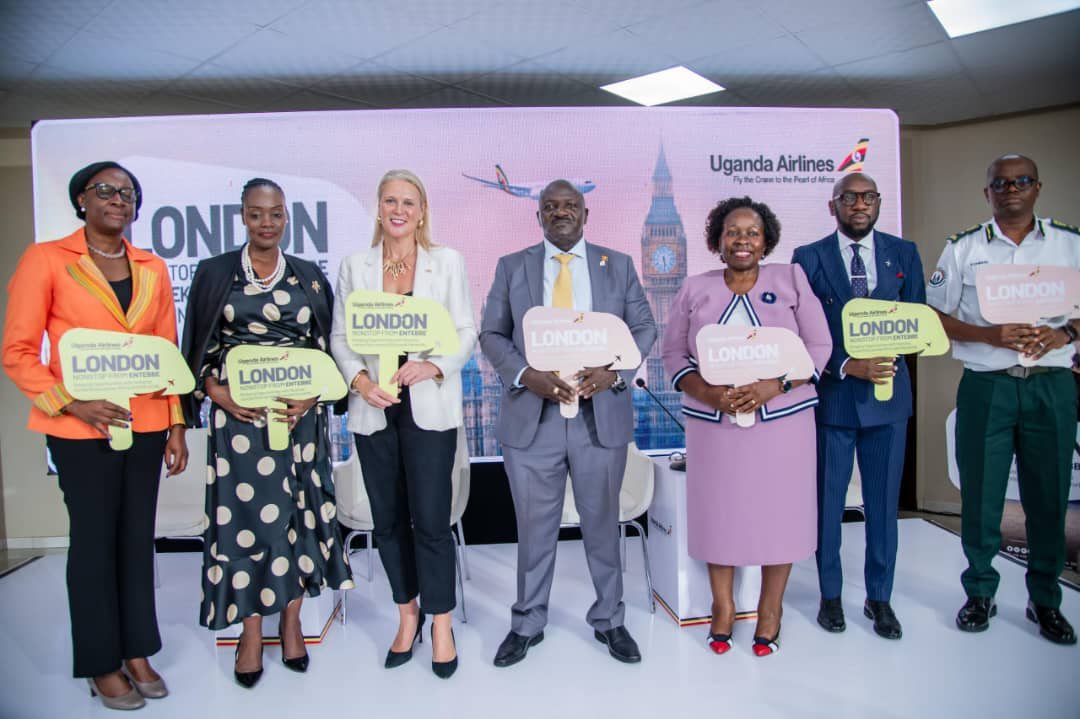Aviation
How a Ugandan Content Creator Can Get Their Product on In-Flight Entertainment
In-flight entertainment (IFE) presents a valuable opportunity for content creators to reach a global audience being millions of passengers flying at 30,000 feet, all looking for distraction.

In-flight entertainment (IFE) presents a valuable opportunity for content creators to reach a global audience being millions of passengers flying at 30,000 feet, all looking for distraction. For a Ugandan filmmaker crafting a drama about Kampala’s bustling streets, a musician blending Luganda lyrics with Afrobeat, or a game developer programming a mobile adventure inspired by Lake Victoria, IFE offers a unique platform. However, how can a creator from Uganda break into this high-flying market? With airlines like Ethiopian Airlines, Emirates, and Uganda Airlines connecting Africa and beyond, the path is challenging but achievable. Here’s a step-by-step guide, informed by industry leaders like Safran Passenger Innovations (SPI) and Anuvu, tailored to a Ugandan perspective.
Step 1: Craft IFE-Ready Content Airlines prioritize content that captivates a diverse audience while adhering to strict guidelines. Begin by ensuring your product aligns with IFE standards:
- Know Your Audience: IFE serves everyone from business travelers to families. A Ugandan short film, like the hypothetical “Kampala Hustle,” could resonate with East African passengers on Ethiopian Airlines, while a universal story about resilience might appeal to Emirates’ global travelers. Music or games with local flair such as a Ugandan trivia app can also stand out.
- Keep It Short and Sweet: Short-haul flights (e.g., Entebbe to Nairobi) typically favor content that lasts 20-60 minutes, while long-haul routes (e.g., Entebbe to London) are suited for feature-length films or albums. A 30-minute documentary on Uganda’s coffee trade would fit perfectly.
- Polish Production: Invest in quality and aim for 1080p video, clear audio, and subtitles in English (which is mandatory) or in other languages like Swahili, Arabic, or French (a bonus for airlines like Qatar Airways). If budgets are tight, free tools like DaVinci Resolve or Audacity can be helpful.
- Censor Smartly: Airlines avoid content with violence, explicit material, or plane-crash scenes. Edit your work to ensure it is family-friendly and culturally sensitive. This is especially crucial for carriers serving conservative regions.
Make sure to secure your intellectual property rights through Uganda’s Registration Services Bureau (URSB) to ensure you can license your work legally. If your project incorporates third-party music or footage, make sure to clear those rights as well for airlines typically won’t touch content with legal risks.
Step 2: Target the Right Players Uganda’s content creators won’t pitch directly to Boeing or Airbus. IFE agreements typically occur through airlines, content service providers (CSPs), or distributors. Here’s where to focus your efforts:
- Local Airlines: Uganda Airlines, revived in 2019, operates Airbus A330s and CRJ900s equipped with IFE systems. Its focus on East African routes makes it a natural fit for Ugandan content. Reach out to their marketing or passenger experience team via their website (ugandairlines.com) or LinkedIn.
- Regional Giants: Ethiopian Airlines, a Star Alliance member with over 150 aircraft, partners with Anuvu for IFE and emphasizes African content (including Nollywood and Ethiopian films). Pitching to them could spotlight Ugandan stories across their extensive network.
- Global CSPs: Companies such as Anuvu and Safran Passenger Innovations dominate IFE delivery. Anuvu, which works with clients like Air Canada and TUI Airways, curates over 600 films for Ethiopian Airlines, including regional selections. Safran’s RAVE system, used by Lufthansa and ANA, supports diverse content on its seatback screens. Both accept submissions—Anuvu via distribution.anuvu.com, and Safran through its office in Brea, California.
- African Distributors: Firms like Kenya’s Multichoice or Nigeria’s Afrinolly may bundle Ugandan content into IFE packages. Network at events like FESPACO, Burkina Faso’s film festival, to make connections.
Step 3: Pitch Like a Pro With airlines and CSPs receiving hundreds of pitches, yours must stand out:
- Create a Pitch Package: Include a one-page synopsis (e.g., “A Ugandan musician’s journey from Gulu to global stardom”), runtime, target audience (e.g., East African travelers), and a trailer or demo. Highlight the cultural value, Uganda’s vibrant arts scene is a notable selling point.
- Offer Affordable Terms: While blockbusters can cost over $90,000 per license, indie content may start at $5,000-$20,000 for 2-3 months. Propose a trial run on Uganda Airlines’ Entebbe-Dubai route to demonstrate demand.
- Email Strategically: For Anuvu, use their media inquiries email or reach out to LinkedIn contacts in their content team. For Safran, connect with SPI’s acquisition representatives. Highlight how your work aligns with their technology e.g., RAVE’s Bluetooth audio compatibility suits Ugandan music playlists.
- Leverage Uganda’s Film Scene: Cite successes like “Queen of Katwe” (Disney, 2016) or the Uganda Film Festival to illustrate market potential. If you have won local awards, be sure to showcase them.
Step 4: Deliver and Negotiate If interest arises, be ready to finalize the deal:
- Provide Files: Deliver DRM-ready files (e.g., MP4 format with encryption) via secure platforms like WeTransfer. Anuvu’s Open™ platform or Safran’s RAVE OS can provide guidance on format specifications and please don’t hesitate to ask for their technical sheets.
- Negotiate Terms: Expect a 2-6 month license covering specific routes (e.g., Entebbe to Addis Ababa). Retain rights for streaming platforms like iROKOtv to maximize revenue. Consider consulting a lawyer from Kampala’s legal community to help with contract details.
Step 5: Amplify and Grow
- Promote Locally: Announce your partnership on platforms like X or Uganda’s NTV with a message like “Now on Ethiopian Airlines!” to generate excitement. Be sure to tag
@anuvu_official or @Ug_Airlines to increase visibility.
- Track Success: Request viewership statistics from the airline or content service provider (CSP) to help pitch for renewals or new projects.
- Scale Up: Use this initial success to approach larger carriers like Emirates or pitch at global events such as APEX Expo (USA) or DISCOP (Africa’s content market).
With Safran’s technological innovation and Anuvu’s content reach, Uganda’s creative voices can gain global recognition, one flight at a time.
Aviation
Everything You Need to Know About the Airbus A320 Family
The family offers a range of aircraft tailored to diverse demands.

The Airbus A320 Family stands as a titan in commercial aviation, shaping the way millions travel across the globe. These single-aisle, twin-engine jets, known for their efficiency and versatility, serve routes ranging from short regional hops to transatlantic journeys. Whether you’re a passenger, an aviation enthusiast, or simply curious about the planes flying overhead, here’s an essential guide to the A320 Family and its significance.
The story of the A320 began in 1984 when Airbus, a European aerospace leader, aimed to challenge Boeing’s dominance with the 737. The first A320 took flight in 1987 and joined Air France’s fleet in 1988, introducing a revolutionary feature: fly-by-wire technology. This digital control system replaced traditional manual controls, enhancing safety and precision. Since then, Airbus has expanded the family to include four models; the A318, A319, A320, and A321, each designed for specific routes and passenger needs. With over 18,000 orders and 11,000 deliveries, the A320 Family has become a cornerstone of modern aviation.
The family offers a range of aircraft tailored to diverse demands. The A318, the smallest, seats 107 to 132 passengers and has a range of up to 5,700 km, although its higher per-seat costs make it less common. The A319, with a capacity of 124 to 156 seats and a 6,900 km range, excels on regional routes and high-altitude airports. The A320, the family’s workhorse, carries 150 to 180 passengers over 6,100 km and serves airlines like easyJet and Delta. The A321, the largest, accommodates 185 to 236 passengers and reaches 7,400 km; its A321XLR variant can extend this range to 8,700 km for long-haul flights. All models come in Current Engine Option (CEO) and New Engine Option (NEO) versions, with NEOs delivering 15-20% better fuel efficiency thanks to advanced engines and sharklet wingtips.
Innovation defines the A320’s design. Its fly-by-wire system, a first for commercial jets, prevents dangerous maneuvers and eases pilot workload. The cabin, measuring 3.7 meters in width, is the roomiest in its class, offering comfortable seating. NEO models include modern touches like LED lighting and larger overhead bins. A shared cockpit and systems across models allow pilots to switch between variants with minimal retraining, saving airlines significant costs. These features make the A320 a preferred choice for both low-cost and legacy carriers.
Performance is another strength of the A320 Family. Cruising at Mach 0.78 (approximately 829 km/h), the A320 Family is capable of handling short flights, medium-haul routes, and, with the A321XLR, transatlantic journeys. The A320neo burns just 2.0 liters of fuel per passenger per 100 km, rivaling smaller jets. Operating costs average around $3,000–$4,000 per flight hour for an A320neo, combined with a 99.7% dispatch reliability, which helps keep airlines profitable. From IndiGo’s budget flights to Lufthansa’s premium services, the A320 adapts to various market needs.
Safety is a hallmark of the A320 Family, boasting a fatal accident rate of 0.08 per million flights, outperforming older single-aisle jets. Its advanced avionics, including terrain and collision avoidance systems, enhance its safety record. A notable incident in 2009, US Airways Flight 1549, an A320, safely ditched in the Hudson River after bird strikes, with all 155 aboard surviving. This incident highlighted the aircraft’s robust design. A tragic crash in 2015 involving Germanwings, caused by pilot intent rather than aircraft malfunction, led to industry-wide mental health reforms, underscoring the importance of ongoing safety improvements.
Economically, the A320 drives airline success. List prices range from $100 million for an A319neo to $130 million for an A321neo, although discounts are often negotiated. Low fuel and maintenance costs make it a staple for budget airlines, while its range suits legacy carriers. Environmentally, NEO models reduce CO2 emissions by 15% and noise by 50%, emitting about 1.8 tons of CO2 per 1,000 km. Airbus is actively testing sustainable aviation fuels and exploring hydrogen-powered successors for 2035, aiming for a greener future.
The A320 Family continues to evolve. The A321XLR, certified in 2024 and delivered to Iberia, flies 4,700 nautical miles, enabling low-cost transatlantic routes. Converted A320s and A321s are meeting cargo demands, carrying up to 27 tons for e-commerce giants. Airbus’s Skywise platform uses fleet data to predict maintenance needs, boosting operational efficiency. Despite past supply chain challenges, Airbus aims to produce 75 aircraft monthly by 2026, supported by 7,000 orders, primarily for NEOs.
The A320 Family is more than just an aircraft, it’s a catalyst for affordable travel and global connectivity. Its blend of efficiency, safety, and innovation ensures it remains an icon in the skies, comfortably transporting passengers while shaping the future of aviation with sustainable advancements.
Aviation
Why Achieving Profitability in Aviation Takes Time and Determination – A Lesson for Ugandans

For Ugandans envisioning a national airline soaring proudly across Africa and beyond, the recent announcement of Kenya Airways’ first profit in 11 years revealed in March 2025 offers a spark of hope. After over a decade of consistent losses, the Kenyan national carrier posted a net profit of 5.4 billion Kenyan shillings (about $41.7 million USD) for 2024. While this “historic” turnaround is commendable, it also underscores a sobering reality being that the aviation is an unforgiving, capital-intensive industry. For Uganda, which lacked a functioning national airline from the collapse of Uganda Airlines in 2001 until its 2019 relaunch, the path to profitability will likely be just as long and demanding. Here’s why turning a profit in aviation is a marathon, not a sprint and what Ugandans should know before investing hope and resources into the skies.
Launching and running an airline is exorbitantly expensive. Just acquiring aircraft is a massive undertaking for a single Boeing 737 can cost upwards of $100 million to purchase or several million annually to lease. Fuel costs alone account for 20% to 30% of operating expenses and fluctuate with volatile global oil markets. Add to this salaries for pilots, cabin crew, maintenance technicians, and ground staff, along with airport fees, insurance, and servicing costs, and it becomes clear that billions of shillings are required just to get off the ground.
On the revenue side, ticket sales are closely tied to factors beyond an airline’s control ie. tourism, economic health, and business travel. Competition is stiff. Industry giants like Ethiopian Airlines and budget carriers keep fares low, shrinking margins. Uganda’s domestic market is relatively small, with a population of 47 million and a GDP per capita of about $1,000. Filling aircraft consistently, especially on long-haul routes, is a long-term task. Kenya Airways carried 5.23 million passengers in 2024, thanks to years of route development and infrastructure investment.
Globally, aviation has often been a loss-making business. According to the International Air Transport Association (IATA), airlines have cumulatively lost more money than they’ve earned over the last century. Even when profits appear, they’re typically thin—ranging between $5 and $10 per passenger. Kenya Airways’ 11-year stretch of losses isn’t an anomaly. Italy’s Alitalia collapsed in 2021 despite years of government bailouts, and South African Airways has faced chronic financial issues. Even Richard Branson once quipped, “The quickest way to become a millionaire is to start as a billionaire and buy an airline.”
Kenya Airways’ recent profitability offers both hope and caution. Much of its 2024 success is attributed to a stronger Kenyan shilling, which helped reduce the burden of dollar-denominated debt. Operational revenue only rose by 6%, suggesting the profit was more a result of financial shifts than business transformation. Since 2013, the airline had consistently operated at a loss, relying heavily on government bailouts like the 2017 takeover of its loans to reduce debt pressure.
The COVID-19 pandemic grounded planes worldwide, inflicting $137 billion in airline losses in 2020 alone. Conflicts, recessions, or supply chain delays (e.g., aircraft parts) compound risks. Kenya Airways weathered some of these storms thanks to its Nairobi hub and alliances with global carriers like Delta.
Despite the risks, a national airline holds symbolic and strategic value. It’s not just about profits, it’s about sovereignty, connectivity, and economic opportunity. For Uganda, a homegrown airline means direct links to trade partners, easier tourist access to treasures like Bwindi’s gorillas and the Nile, and enhanced export capacity for goods like coffee and flowers. This could translate into thousands of jobs, infrastructure development, and enhanced global presence.
The key takeaway for Ugandans is this: success in aviation doesn’t come quickly or cheaply. Kenya Airways took over a decade of losses and strategic restructuring to reach its current position. One thing is clear: those hoping for quick wins in the aviation sector should prepare for a long-haul flight.
Aviation
Uganda Airlines Takes Flight to London
Uganda Airlines is committed to delivering a memorable journey with competitive pricing, reduced travel times, and a focus on safety, convenience, and reliability.

Uganda Airlines, the national carrier of the Republic of Uganda, is excited to announce its expansion into the European market with the launch of direct flights to London Gatwick. Set to commence on May 18, 2025, this new route will feature four weekly nonstop flights between Entebbe International Airport (EBB) and London Gatwick (LGW), marking a historic milestone in the airline’s five-year journey. This service not only re-establishes a direct air link between Uganda and the United Kingdom after nearly a decade but also positions Uganda Airlines as a key player in connecting two vibrant markets.
The airline has tailored its flight schedule to maximize convenience for passengers. Operating on Sundays, Tuesdays, Wednesdays, and Fridays, the flights are designed to cater to both business and leisure travelers. Most departures from Entebbe are night flights, allowing passengers to enjoy dinner in Entebbe and arrive in London for breakfast, except for the Sunday morning flight. Specific flight details include:
EBB to LGW:
- Sunday: Departs 09:25, Arrives 16:55
- Tuesday: Departs 00:05, Arrives 07:35
- Wednesday: Departs 00:25, Arrives 07:55
- Friday: Departs 03:10, Arrives 10:40
LGW to EBB:
- Sunday: Departs 19:05, Arrives 06:35
- Tuesday: Departs 09:40, Arrives 21:10
- Wednesday: Departs 09:50, Arrives 21:20
- Friday: Departs 12:40, Arrives 00:10
The route will be serviced by the cutting-edge Airbus A330-800neo, which features a three-class cabin configuration: 20 flatbed seats in Business Class, 28 seats in Premium Economy, and 210 seats in Economy Class. Passengers can expect a generous baggage allowance of up to 30 kg (two pieces) for Economy Class and 32 kg (two pieces) for Business Class, ensuring a hassle-free travel experience.
Uganda Airlines is committed to delivering a memorable journey with competitive pricing, reduced travel times, and a focus on safety, convenience, and reliability. By eliminating stopovers, the airline offers one of the fastest connections between Entebbe and London, catering to the needs of both business professionals and leisure travelers. Tickets are now available for booking through the airline’s website, the Uganda Airlines app, booking offices, and authorized travel agents.
The decision to launch flights to London is based on a combination of market demand and strategic opportunities. Entebbe has long been identified as one of Africa’s top unserved markets for London, with travelers previously relying on multiple stopovers via the Middle East, Europe, or other African hubs. Uganda Airlines’ direct service fills this gap, offering a seamless travel option.
This route also strengthens economic and cultural ties between Uganda and the UK. The United Kingdom is a vital trading partner for Uganda, with significant potential for growth in exports such as coffee, tea, bananas, and cut flowers. Additionally, the UK is a major source of Foreign Direct Investment (FDI) in sectors such as oil and gas, manufacturing, tourism, and financial services. The direct link is expected to catalyze these opportunities, enhancing Uganda’s competitiveness on the global stage.
Tourism is another key driver, with the UK ranking among Uganda’s top seven visitor markets. Known as “The Pearl of Africa,” Uganda boasts unparalleled attractions, including gorilla tracking, national parks, and a rich cultural heritage. The new route will make these experiences more accessible to British travelers, boosting Uganda’s tourism sector.
For the Ugandan diaspora in the UK, estimated at 51,000 Ugandan-born residents, alongside a larger community of Ugandan Asians—direct flights will foster stronger connections with their homeland. Similarly, the route will ease travel for Ugandan students pursuing education in the UK, a popular destination for higher learning.
Beyond convenience, the London route enhances Uganda’s air transport connectivity, supporting the country’s economic transformation. By reducing reliance on foreign operators, Uganda Airlines aims to make air travel more affordable for Ugandans while reinforcing its hub at Entebbe. The airline’s expanding network spanning destinations like Nairobi, Johannesburg, Lagos, and soon Accra further amplifies these benefits, offering seamless connections across Africa and beyond.
Since its inception in August 2019, Uganda Airlines has built a reputation for excellence, operating a modern fleet that has earned the Ch-Aviation Youngest Aircraft Fleet Award for five consecutive years. The launch of the London route is a testament to the airline’s ambition and its role in elevating Uganda’s presence in global aviation.
Chief Executive Officer Ms. Jenifer Bamuturaki expressed her enthusiasm: “This route is a game-changer for Uganda Airlines and our passengers. We’re proud to connect Uganda directly to London, fostering trade, tourism, and cultural exchange while delivering a world-class travel experience.”
-

 Entertainment5 months ago
Entertainment5 months agoMuseveni’s 2025 Copyright for Musicians breakdown
-

 Business5 months ago
Business5 months agoUganda’s Ministry of Finance projects significant growth opportunities in 2025
-

 Policies5 months ago
Policies5 months agoBreakdown of the Uganda Police Force Annual Crime Report 2024
-

 Health5 months ago
Health5 months agoBreaking down the Malaria Vaccine Rollout in Uganda
-

 Entertainment5 months ago
Entertainment5 months agoIsaiah Misanvu Teams Up with Nil Empire for a Soul-Stirring Anthem of Gratitude and Transformation “Far Away”
-

 Sports4 months ago
Sports4 months agoThe Transformative Impact of World Cup Qualification for Uganda
-

 Policies5 months ago
Policies5 months agoIs Uganda’s Shs10m Fine the WORST Thing for Cohabiting Couples?
-

 Business5 months ago
Business5 months agoUber and Lyft are finally available in all of New York State














